Kargil lessons have relevance for the Agnipath ferment
JULY 4 is a significant date in the 1999 Kargil War, marked by major operational and political events. It offers important cues for the Indian higher defence management edifice amid the current challenges — the Agnipath scheme being the most visible.
Operationally, the capture of Tiger Hill (16,608 ft) by the Ghatak platoon of the 18 Grenadiers battalion was a turning point for India; the Pakistani military led by Gen Pervez Musharraf knew that this was the beginning of the end of a feckless misadventure.
At the political level, then Pakistan PM Nawaz Sharif sought an unscheduled urgent summit meeting with US President Bill Clinton in Washington DC; the outcome was clear. While Sharif sought US intervention to restrain India, Clinton’s message was firm: Pakistani troops had to withdraw to their old positions behind the Line of Control. The beleaguered Pakistan PM had no choice but to accept this ‘advice’; thus, the war came to an inglorious end for Rawalpindi, the General Headquarters of the Pakistan army.
While the war ended officially on July 26, a day celebrated as Vijay Diwas by India, and which will in all probability be packaged as a mega 25th anniversary event this year by the BJP-led NDA government, the deeper import of the outcome of the war and its contemporary relevance merit recall and rumination to contextualise India’s current national security challenges.
The 1999 war can be triangulated in different ways — for instance, the nuclear shadow (both India and Pakistan had demonstrated their nuclear weapon capability in May 1998); or being the first major conflict in the sub-continent after the end of the Cold War in December 1991; or the fact that Atal Bihari Vajpayee was a caretaker Prime Minister. But the most significant outcome of the war, in my view, was the manner in which the BJP-led NDA government encouraged an objective external review of the fiasco by a group of eminent experts.
The Kargil War was a triumph of the indomitable fighting spirit and valour of the Indian soldier, and the capture of Tiger Hill and Tololing are illustrative. This gallantry is to be recalled and cherished, but the sacrifice of precious lives has to be framed against the larger failure of the higher defence leadership of the country.
To his credit, then PM Vajpayee set up a committee on July 29, 1999, headed by defence studies expert K Subrahmanyam, to review the “events leading up to the Pakistani aggression in Kargil district of Ladakh in Jammu & Kashmir; and to recommend such measures as are considered necessary to safeguard national security against such armed intrusions.”
In a rare and commendable manner, the Kargil Review Committee (KRC) completed its task in mid-December 1999 — a month ahead of schedule — and the Kargil report was tabled in Parliament on February 23, 2000. Soon after, the report was published as a book and released in the public domain with some parts redacted. Kargil-1999 exuded a degree of transparency and introspection that still eludes the ill-fated October 1962 debacle at the hands of China. Successive Prime Ministers, from Nehru to Modi, have not mustered the resolve to place the Henderson-Brooks report in the public domain, though pirated versions abound in cyberspace.
Today, 25 years later, it is a matter of shame that many of the major recommendations made by the KRC have neither been deliberated upon in Parliament nor in select committees in an informed and constructive manner. Rather than transparency, it is tenacious opacity and embroidered obfuscation that envelop major national security policy decisions.
The Agnipath scheme to induct young soldiers for a limited four-year period, unveiled in June 2022, is illustrative of this trend. The scheme acquired a high degree of relevance in the 2024 General Election and has come into unsavoury political focus. Much to the discomfiture of the Modi government, a major ally — the JD(U) — was the first to voice its reservations about the scheme. Leader of the Opposition Rahul Gandhi has accused the Defence Minister of misleading Parliament on the matter.
A corrosive political slugfest is gathering momentum, and former Service Chiefs have been brought into the social media kerfuffle. A former Army Chief, Gen Manoj Naravane, in his yet-to-be-published book, referred to a modest pilot scheme proposal mooted by the Army being transformed by the PMO into a radical mega recruitment template to trim the pension bill. Two former naval chiefs (Admirals Arun Prakash and KB Singh) have made public their observations about the inadequacies of the scheme and what they perceived as fiscal compulsions for the hastily launched programme.
Predictably, the Modi government has fielded a former IAF Chief — Air Chief Marshal RKS Bhadauria (who has joined the BJP) — to support Agnipath. A sensitive national security issue is becoming a bitterly polarised political blame game. This is dangerous and avoidable.
The Kargil lessons that may be applied in the current ferment would be for the government to lower the temperatures in Parliament and end the diatribe in the media, while assuring both the Opposition and the aggrieved citizenry that a de novo review of the scheme by a team of eminent apolitical experts would be undertaken in a speedy manner.
This is not the first time that the government of the day has sought to review recruitment policies. Previous reports prepared by Lt Generals K Balaram and Harwant Singh can be re-examined.
In its epilogue, the KRC noted that “the Committee has after very wide interaction sign-posted directions along the path to peace, ensuring progress, development and stability of the nation. How exactly the country should proceed to refashion its Security-Intelligence-Development shield to meet the challenge of the 21st century is for the Government, Parliament and public opinion to determine. There is no turning away from that responsibility.”
The government must rise to this challenge in an empathetic and purposeful manner.









